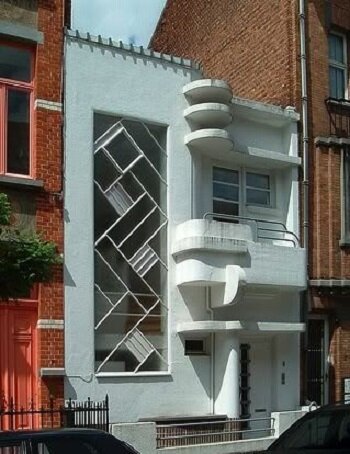#15269. White Modernist Facade: Contrast and Geometry in a Narrow Urban House

Before us is a striking example of modernist architecture that sharply contrasts with the surrounding traditional brick buildings. The snow-white facade of this narrow urban house creates a dramatic contrast with the neighboring brick structures. Particular attention is drawn to the original composition of the facade with geometric protruding elements that create an interplay of light and shadow.
The asymmetrical composition of the facade includes a diagonal lattice structure on the left, which simultaneously serves as a decorative element and, likely, a functional feature for natural lighting. The right side of the facade is adorned with protruding rounded balconies and canopies, creating a dynamic wave-like form. These circular elements effectively contrast with the rectilinear geometry of the diagonal grid.
The minimalist color palette emphasizes the purity of forms and lines. The small volume of the building maximizes the effective use of available space, combining functionality with artistic expressiveness. In the design, one can see the influence of architectural modernism of the mid-20th century with its emphasis on geometry, functionality, and the use of modern materials.
For a contemporary homeowner, this facade demonstrates effective techniques: contrasting color design to highlight the building among the surrounding development, the use of geometric shapes and textures to create visual interest, as well as playing with three-dimensional elements to form a dynamic image. Even with limited space, one can create a memorable architectural appearance that combines functionality with aesthetic expressiveness.